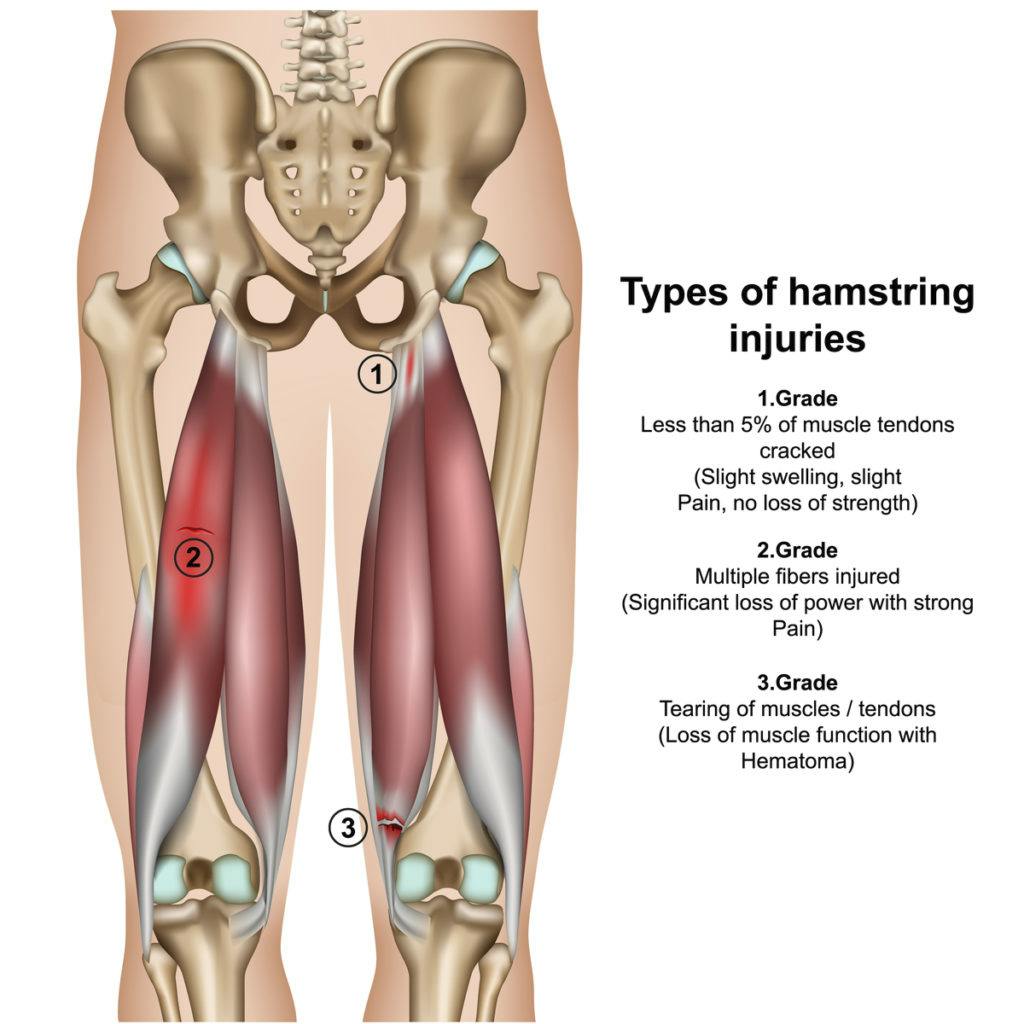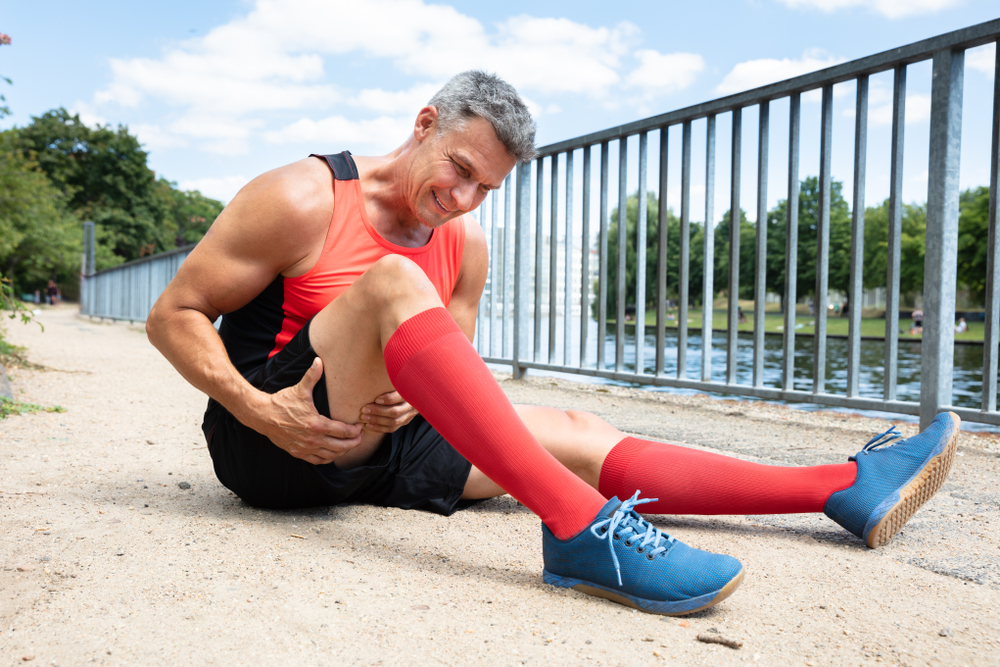Hamstring strains occur at high rates in sports requiring running and sprinting. One of every 3 injuries in soccer is a hamstring strain. Other sports with high injury rates include baseball, football, and track and field. These injuries are very frustrating for athletes because of the long rehabilitation time. Returning to sports may take 2 to 3 months based on the severity of the injury. Also, nearly 1 in 3 hamstring injuries will recur. Many of these happen within the first 2 weeks of returning to sport. Thankfully, rehabilitation exercises will get you back in the game and avoid re-injury.
The Basics of Hamstring Strains
Your hamstrings consist of 3 muscles: your semitendinosus, semimembranosus, and biceps femoris. These 3 muscles start from a common tendon on your pelvis. Your hamstrings cross your hip and knee joints. They attach just below the back of your knee.

Hamstring injuries commonly occur during high-speed running. This occurs as your leg swings from a bent to a straight position in preparation for landing. During this phase of running, hamstring activity is extremely high to control the length of the muscle.
The Most Effective Approach to Rehabilitating Hamstring Strains
3 types of rehabilitation exercises assist in recovery from hamstring strains. Agility exercises involve changes of direction simulating sports movements. These exercises reduce re-injury rates. Always initiate these exercises early after your injury. Core stabilization exercises are also effective at reducing your risk of re-injury. Finally, exercises that lengthen your injured hamstring will speed up your return to play.
The remainder of this article highlights 5 rehab exercises for hamstring strains. Three of the exercises progressively lengthen your hamstrings. These are the active hamstring stretch, the “diver”, and the “glider”. Perform lengthening exercises slowly and through pain-free ranges at first. Aggressive stretching delays recovery. As you improve, gradually increase the speed and range of movement.
Trunk stabilization exercises target your spine, hip, and pelvic muscles. To reduce your risk of re-injury, it is important to strengthen your hamstrings and all surrounding muscles. Keep in mind, that your hamstring muscle group originates from your pelvis. The position of your pelvis during running influences your hamstring muscles. Increasing the strength of your injured hamstring builds resilience and promotes a safe return to sport.
Active Hamstring Stretch
Lie on your back holding your thigh. Keep your opposite leg straight. With your upper thigh in a vertical position, slowly extend your knee. At the point where a mild stretch is felt pause and hold. The stretch should not be painful. Gentle stretching is helpful for recovery. Aggressive stretching of your hamstring will delay your recovery.
Hold this position for 3 to 5 seconds, and then lower your leg back down. Perform 3 sets of 12 repetitions once per day.
Cook Hip Lift
Begin on your back with your hips bent and feet lined up with your shoulders. Pull the knee of the uninjured leg up to your chest. It is helpful to place a small towel roll or ball in the crease of your hip. Lift your toes off the floor and perform a bridge from your other leg. Be sure to achieve the bridge position by extending through your hips, not your lower back.
Hold this position for 2 to 3 seconds then return to the starting position. Perform 2 to 3 sets of 10 to 15 repetitions on each side once per day.
Bridge Walk-Out
Begin on your back with your hips bent and your feet lined up with your shoulders. Perform the bridge by lifting both hips from the floor. Hold the bridge position and alternately walk your feet out away from your body. Maintain a level pelvis throughout the exercise.
After 2 to 3 steps walk your feet back to the starting position. Lower your body back down in a slow and controlled manner between each repetition. Perform 3 sets of 6 to 8 repetitions once per day.
Hamstring “Diver”
This exercise resembles a simulated dive. Stand on your injured leg with your knee slightly bent. Bend forward at the hip and simultaneously stretch your arms forward. Your back remains flat. Your opposite knee remains bent as your hip extends.
Perform this exercise very slowly in the beginning. As a progression, you can increase the speed and range of motion. Typically, 3 sets of 6 to 8 repetitions are performed every other day.
Hamstring “Glider”
Begin in a standing position with one hand holding onto a support. Your legs are slightly split. All your body weight is on the heel of your injured (front) leg with your knee slightly bent. The motion is started by gliding backward on your other leg (wearing only a sock). As always, stop just before pain is felt. The movement back to the starting position is performed with the help of your arms, not using your injured leg.
Begin slowly in a pain-free range of motion. Progress this exercise by increasing the gliding distance and performing the exercise faster. This exercise requires slightly more recovery between each session. Perform this exercise 3 times per week for 3 sets of 6 repetitions
Start Your Exercises for Hamstring Strains Right Away
Your rehabilitation after a hamstring injury should begin as soon as possible. Start agility and trunk stabilization exercises immediately. Also, perform lengthening exercises soon after your injury, but be gentle. It is best to perform these under the supervision of a licensed physical therapist. As always, the progression of any athlete’s rehabilitation program is based on specific criteria.
Your physical therapist will continually assess your injury and progress your program. Our goal is to get you back as quickly and safely as possible. Contact us today if you have had a hamstring strain.

